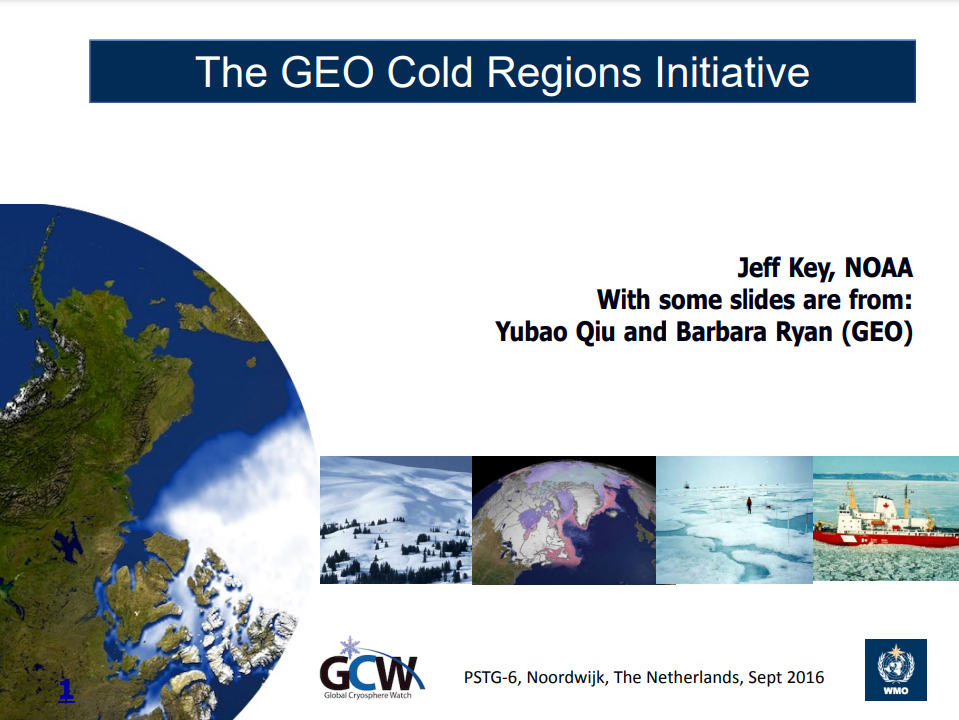GEOCRI Implementation Plan (Long Draft version) to WMO PSTG-6

GEO Cold Regions Initiative Implementation Plan
GEO Work Programme: Global Initiative-11 @ 5/24/2016
The “Cold Regions”, that include the Arctic, Antarctic, high-latitude oceans, Himalaya-ThirdPole and Mountain cold areas, are experiencing the fastest rate of climate, ecological andenvironmental change. With its abundant Earth water and relevant phase changing, the coldregions severely affect the dynamic earth’s systems, impact more than one hundred countries ofbillions of people living therein, and influence many aspects of society in all parts of the world.Recent scientific research is making it increasingly clear that “What happens in the polesdoesn’t stay in the poles”.
Aiming to share the vision of the intergovernmental Group on Earth Observations (GEO) toaddress the global environmental change, and its resulting impacts and challenges on all aspectsof society, an Information Service for Cold Regions was established to broaden and share Earthobservations for societal benefit, and inform the decision makers, through strengthening coldregions coordination with diverse communities, and engagement and collaboration ofstakeholders including decision makers.
Building on these accomplishments during the first phase of Information Service for ColdRegions in the first 10-year implementation of GEOSS, the GEO Cold Regions Initiative(GEOCRI) was proposed and accepted by GEO XII plenary in November, 2015, which is also aYear of Polar Prediction (YOPP) endorsed initiative.
By recognizing the scientific and societal requirement over the Earth cold regions, the GEOCRI vision is to provide coordinated Earth observations and information services across a range ofstakeholders to facilitate well-informed decisions and support the sustainable development of theCold Regions globally.
The GEOCRI mission is to develop a user-driven approach for Cold Regions informationservices to complement the mainly current science-driven effort. The Cold Regions InformationService will strengthen synergies between the environmental, climate, and cryosphere researchefforts and foster the collaboration between the Arctic, Antarctic, high-latitude oceans,Himalaya-Third Pole and Mountain cold area for improved earth observations and informationon a global scale.
The GEOCRI community consists of a team of Task leads, contributors and observers.Contributors can join theme-specific Task Teams to work on specific activities according to theirinterests. The co-lead team works together on, for example, user engagement and generalcoordination and reporting of the GEOCRI activities. In addition, an institution, foundation orinterested group can join GEOCRI as an Observer, which means that they will be updated aboutthe progress and activities, without not directly taking part in the activities. An AdvisoryCommittee, consisting of high-profile scientists, leaders of relevant communities, for example,will be convened in late 2016 - early 2017 to provide advice and guidance on the GEOCRIactivities. Terms of Reference will be developed in 2017 to verify the institutional managementand coordination structure for GEOCRI.
Plan with time, approaches, milestones, and deliverables and task teams. The activitiesconducted in GEOCRI are grouped into six tasks: Data, Infrastructures, Training, CapacityBuilding and Knowledge Transfer, User Engagement and Communication, In situ and RemoteSensing Integration and S&T, and Monitoring and Management. Each Task consists of activitieswith set milestones and deliverables during the Work Program 2017-2019. The range ofdeliverables varies from activity reports to stakeholder and user mapping to training and capacitybuilding events and webinars. Majority of the milestones and deliverables of the 2017-2019implementation plan are set to the two first years of the programme period in order to add newmilestones and deliverables, geared towards the transition from implementation to operationalstage starting in 2019 and during the next work programme period 2020 onwards.
Most of the GEOCRI’s resources are in-kind efforts, and are aimed at leveraging the resources ofparticipating initiatives and organizations to align with GEOCRI’s objectives